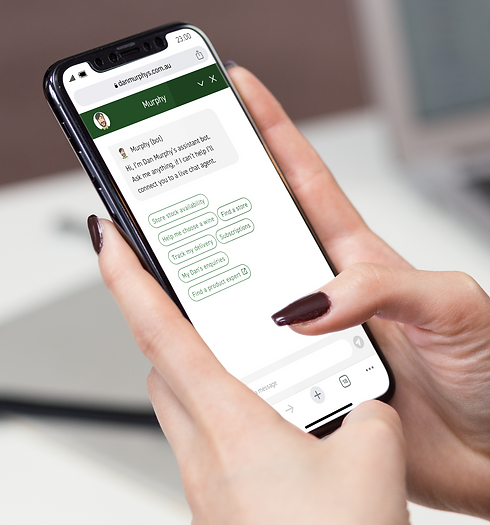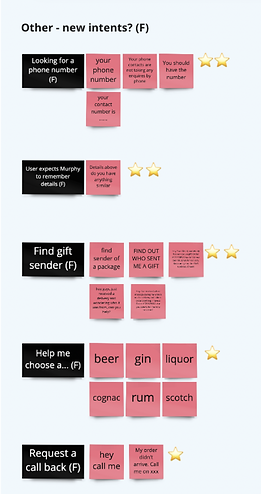
Dan Murphy's chatbot
This case study explores how conversational design, UX writing, and qualitative and quantitative research methods were used to create an effective user experience.
scroll
Project overview
Summary & team
Murphy is Dan Murphy’s assitant bot that helps users self-serve with frequent customer service requests, eg. tracking a delivery, updating their personal details, etc. I worked as the sole UX designer alongside a software developer, project manager & data analyst.
Goal & hypothesis
Murphy bot's subpar Voice of the Customer (NPS) scores and high service request volume prompted an investigation into its shortcomings. I assumed that a lack of a human touch and empathy in the bot's communication could be contributing factors.
Process
I delved into customer feedback analysis and explored user messaging nuances to formulate UX recommendations and refine content. The process covered research, ideation, and implementation, ultimately enhancing our team's proficiency in UX writing for future projects.

Insights
Analysing qualitative customer feedback
Affinity mapping a sample of customers’ feedback data helped me understand some of the issues that users encountered when engaging with the chatbot.
Users were left with their questions unanswered because Murphy bot was not intuitive enough.
Users felt limited by the number of options on the initial menu and didn’t understand that they can ask any question.
Users generally preferred talking to a human.
Investigating what users ask Murphy bot
What exactly were users asking Murphy? Turning to the user questions and comments, helped me gain the following insights:
Murphy bot couldn’t process natural conversational input or slang phrases.
Murphy bot had missing functionalities that users needed, eg looking up who sent them a gift.
Murphy bot couldn’t understand compound sentences or more than one user request at a time.
Insights

Outcomes

Before & after dialogue

Examples of a UX writing workshop activity


A more conversational approach to humanise Murphy
Murphy’s robotic and systematic language was a big area to improve on which lead me to perform a copy & UX writing audit and rework of all of Murphy’s conversational dialogue.
The goal here was to eliminate some of the anxiety users felt about engaging with AI and to imitate a natural human conversation.
A team focused on conversational writing
I wanted to enable all team members who contribute to Murphy’s creation and success to be able to write in a conversational and ‘UX-minded’ way. I ran UX writing workshops with the team to create awareness and give them the tools to make Murphy’s design a success.
Training Murphy with new phrases and variations thereof
Google’s Dialogflow hosts all of Murphy’s conversational pathways. It allows you to add training phrases to enable better machine learning.
Auditing and reworking the phrases where users were having trouble finding what they were looking for, helped minimise the number of roadblocks users encountered and the need they had to rather connect with a live agent.
New initiatives to broaden Murphy’s capabilities
Knowing what users were trying to use Murphy for, helped the team understand where to take him in the future in terms of adding on features.
These include, for example, Murphy being able to:
-
know when a product will be in stock
-
compare the prices of different products
-
recommend a wider range of product types or cocktail recipes
Impact
Murphy bot’s NPS score improved from -49 to -32 over a 4 month period.
Number of live chat interactions which Murphy bot can handle himself decreased.
New feature opportunities & a backlog of ideas were created.
The team has a humanised focus for designing & building Murphy.
Murphy bot’s ability to process more variations of natural conversation helps users find what they need faster. They also don’t have to frustratingly retry multiple ways of saying the same thing to help Murphy understand.
Customer care agents are freed up to take care of urgent customer queries because Murphy bot is capable of doing what he was designed to do - handle the frequent and menial customer questions. The business, therefore, reduces expenses for additional manpower.


